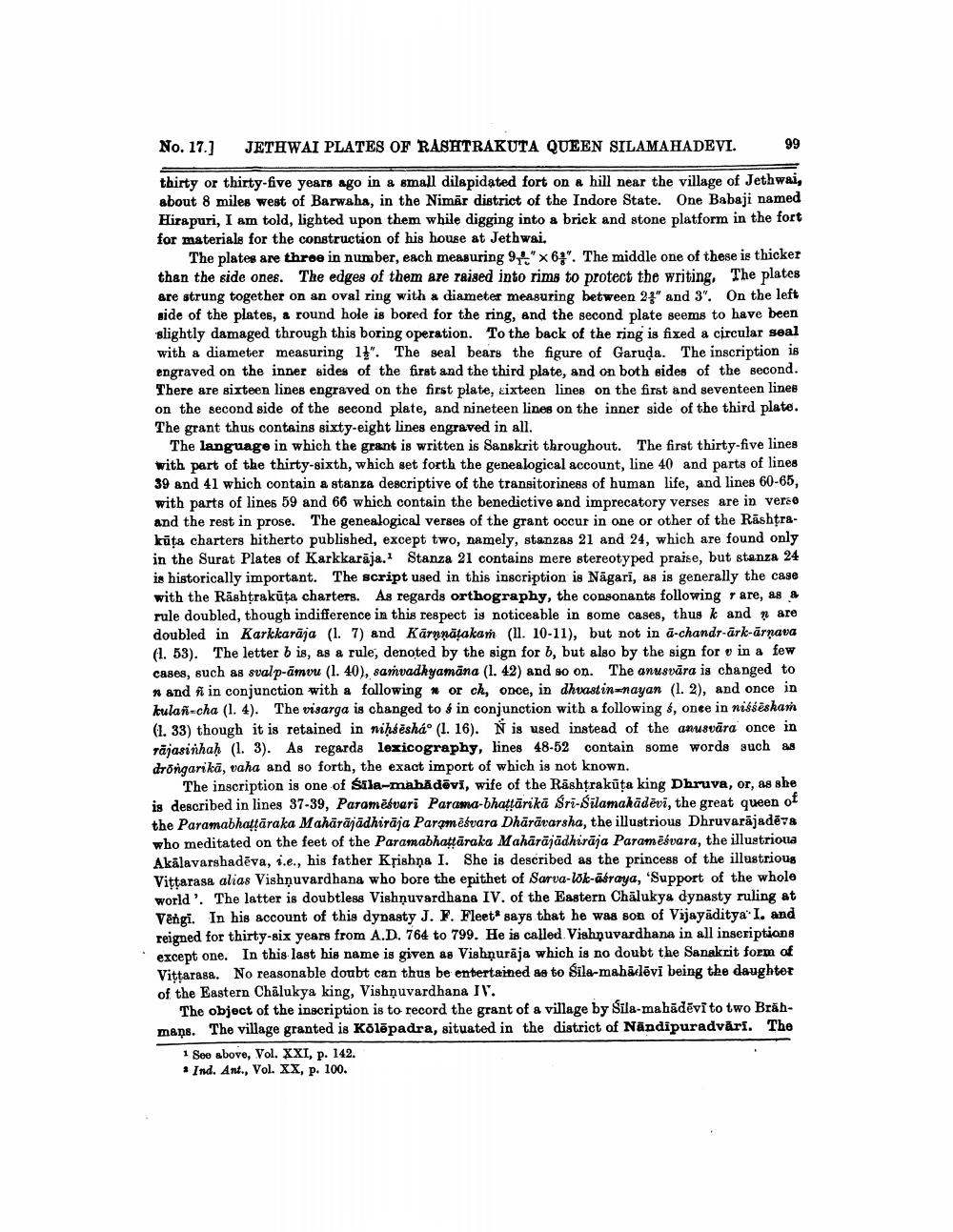________________
No. 17.)
JETHWAI PLATES OF RASHTRAKUTA QUEEN SILAMAHADEVI.
99
thirty or thirty-five years ago in a small dilapidated fort on a hill near the village of Jethwai, about 8 miles west of Barwaha, in the Nimār district of the Indore State. One Babaji named Hirapuri, I am told, lighted upon them while digging into a brick and stone platform in the fort for materials for the construction of his house at Jethwai.
The plates are throe in number, each measuring 91." x 67". The middle one of these is thicker than the side ones. The edges of them are raised into rims to protect the writing. The plates are strung together on an oval ring with a diameter measuring between 24" and 3". On the left side of the plates, a round hole is bored for the ring, and the second plate seems to have been slightly damaged through this boring operation. To the back of the ring is fixed a circular seal with a diameter measuring 11". The seal bears the figure of Garuda. The inscription is engraved on the inner sides of the first and the third plate, and on both sides of the second. There are sixteen lines engraved on the first plate, sixteen lines on the first and seventeen liner on the second side of the second plate, and nineteen lines on the inner side of the third plate. The grant thus contains sixty-eight lines engraved in all.
The language in which the grant is written is Sanskrit throughout. The first thirty-five lines with part of the thirty-sixth, which set forth the genealogical account, line 40 and parts of lines 39 and 41 which contain a stanza descriptive of the transitoriness of human life, and lines 60-65, with parts of lines 59 and 66 which contain the benedictive and imprecatory verses are in verso and the rest in prose. The genealogical verses of the grant occur in one or other of the Rashtrakūța charters hitherto published, except two, namely, stanzas 21 and 24, which are found only in the Surat Plates of Karkkarāja. Stanza 21 contains mere stereotyped praise, but stanza 24 is historically important. The script used in this inscription is Nāgari, as is generally the case with the Rashtrakūta charters. As regards orthography, the consonants following are, as rule doubled, though indifference in this respect is noticeable in some cases, thus k and are doubled in Karkkarāja (1.7) and Kärnnātakaṁ (11. 10-11), but not in a-chandt-ārk-arnava (1. 53). The letter b is, as a rule, denoted by the sign for b, but also by the sign for u in a few cases, such as svalp-āmvu (1. 40), samvadkyamāna (1. 42) and so on. The anusvāra is changed to n and ñ in conjunction with a following * or ch, once, in dhvastin=nayan (1.2), and once in kulan-cha (1. 4). The visarga is changed to é in conjunction with a following é, onee in niśśēsham (1.33) though it is retained in nihkësháo (1. 16). N is used instead of the anusvāra once in rājasinhaḥ (1. 3). As regarda lexicography, lines 48-52 contain some words such as drorgarikā, vaha and so forth, the exact import of which is not known.
The inscription is one of Sila-mahādēvi, wife of the Rashtrakūta king Dhruva, or, as she is described in lines 37-39, Paramēsvari Parama-bhattārikā Śri-Silamakādēvi, the great queen of the Paramabhattāraka Mahäräjädhiraja Paramēśvara Dhārāvarsha, the illustrious Dhruvarājadē78 who meditated on the feet of the Paramabhattāraka Mahārājādhirāja Paramēśvara, the illustrioua Akālavarshadēva, i.e., his father Krishna I. She is described as the princess of the illustrious Vittarasa alias Vishņuvardhana who bore the epithet of Sarva-lok-äfraya, 'Support of the whole world'. The latter is doubtless Vishnuvardhana IV. of the Eastern Chalukya dynasty ruling at Vēngi. In his account of this dynasty J. F. Fleet says that he was son of Vijayāditya I. and reigned for thirty-six years from A.D. 764 to 799. He is called Vishnuvardhana in all inseriptions except one. In this last his name is given as Vishnurāja which is no doubt the Sanskrit form of Vittarasa. No reasonable doubt can thus be entertained as to Sila-mahādēvi being the daughter of the Eastern Chalukya king, Vishnuvardhana IV.
The object of the inscription is to record the grant of a village by Sila-mahādēvito two Brahmaņs. The village granted is Kölēpadra, situated in the district of Nāndipuradväri. The
1 See above, Vol. XXI, p. 142. • Ind. Ant., Vol. XX, p. 100.




